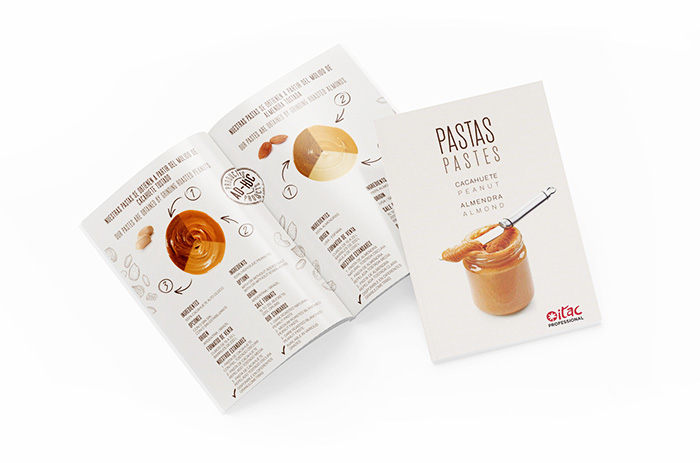What are nut butters?
Over the past few years, the popularity of nut and seed-based butters has increased considerably. A few years ago, peanut butter was the most widely consumed nut spread used as an alternative to dairy butter, but the development of technology and consumer awareness of the nutritional properties of nuts and seeds has led to the development of countless varieties.
Let’s begin by placing them in the category called spreads: this is the group of foods that, as indicated by the word itself, can be spread by the consumer. Which ones are we talking about? Well, there is butter, paste, cream, jam and sweet and savoury pâtés. We will focus on what we know best: nut butters and pastes.
What is the difference between them? There are no criteria when it comes to naming them, since each manufacturer decides on the name it wants to give to its products and, at present, there is no legislation regarding this topic in the European Union.
At Importaco, our speciality is nut pastes, which we manufacture and market under the brand name Itac Professional for the food industry: as ingredients 100% peanuts and 100% almonds, with no additives, no stabilisers and no saturated fats. We also make butters, which are those that contain other ingredients such as salt, sugar, oil and in some cases, stabilisers.
How do we make nut butter?
The process to transform peanuts and almonds into paste begins with the analysis and selection of the raw material, which is then removed from the shell and cleaned of any residues that come from the field. Then, depending on the type of paste, the skin can be removed, or the nut can be processed with it.
You may be interested: Discover all about almond processing
Then, it is roasted and, depending on the level of roasting, the paste acquires a shade between brown and beige. Afterwards, coarse grinding is carried out to obtain either a very thick or dense paste, or fine grinding to obtain a more liquid or smoother paste. Temperatures during roasting, grinding and storage are vital in preserving the nutritional properties of nut pastes.
To determine the quality of the paste, we look at its particle size, which can range from very coarse to very fine (less than 0.035 mm or 35 microns). The selection of the paste’s particle size depends on its intended use. Colour, moisture and viscosity are other factors considered to define and control the quality of these products.
Where are nut butters used?
We are familiar with the jars of paste or butter sold in shops, supermarkets and hypermarkets for home consumption, but paste and butter are used also as ingredients in the food industry.
The most liquid or smoothest pastes below 35 microns, skinless and lightly roasted are used mainly for the production of plant-based drinks, yoghurt and smoothies. Thicker or denser pastes with a particle size greater than 80 microns, more roasted and sometimes with skin are used to make food products to meet nutritional needs for sports. Also, for the manufacture of nougat, ice cream, sweets and cookies.
These properties and uses that we have described are not a standard to follow in the process of preparing these foods—rather, usage will depend on the manufacturer and the specific needs for the final product. That is why at Importaco we manufacture nut pastes with the technical specifications that our customers need, because we know that quality and food safety are essential to satisfy the final consumer.
Recommended reading: Discover the possibilities of nut pastes
Consumption trends of nut butters
The Institute of Food Technologists notes that as more consumers choose to eat vegetarian or vegan food, their expectations of plant-based products increase. Better taste, texture and colour, clean label, high protein, sustainability… the list of “must-have” attributes continues to grow.
Vegetarian products are attracting consumers of all kinds, from strict vegans to flexitarians—who are sometimes meat eaters—, as well as unconditional omnivores. Only 12% of buyers of plant-based products describe themselves as vegetarian, according to a 2019 survey by the Hartman Group. Plant-based drinks are the best-sellers in their food category, followed by the plant-based “meat” segment.
Looking ahead, investment firm UBS predicts that U.S. sales of plant-based “dairy” products will reach $37.5 billion by 2025, and plant-based protein and meat alternatives will reach $85 billion by 2030.
Meanwhile, the range of ingredients available to formulate new and improved vegetarian products continues to expand to make plant-based foods that directly replace animal products.
Market data
Present in three-quarters of America’s pantries, peanut butter is truly an American staple. According to data provided by The Peanut Institute, around 774 million euros of this product are consumed each year.
In Western Europe, Euromonitor indicates that consumption has increased by 14% from 2005 to 2018, reaching the impressive figure of 314 million euros! More than 50% of peanuts grown are eaten in the form of peanut butter.
And why not? Children know it as a sandwich filling; adults use it as an ingredient in sauces and spreads, or as a protein supplement—and everyone loves it. Although it began as a simple vegetarian protein alternative, peanut and almond pastes have many benefits and have become one of the most affordable, nutritious and delicious foods available today.
Want more information about our products? Take a look at our nuts catalogue for the food industry.
Sources
The Peanut Institute. Peanut butter
The Institute of Food Technologists. Beyond Soy: Formulating Vegan and Vegetarian Foods
US National Library of Medicine – National Institutes of Health. Plant based butters





